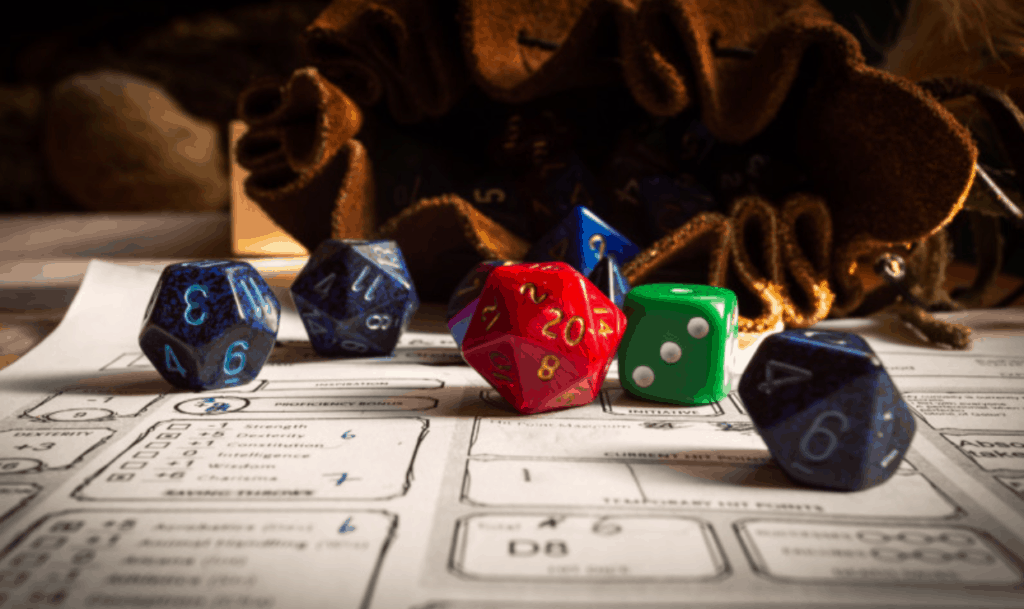Sometimes you don’t want to play the charging warrior slicing his way through his enemies, or the powerful wizard turning entire armies to ashes. Sometimes you want to play the oft-underappreciated until the nat ones start being rolled support class. This allows you to heal and buff your allies, and apply critical debuffs to your enemies. Any class can be a support class, but some classes tend to lean towards it with powerful spells and abilities.
Take the cleric for instance, as it can be a devastating holy warrior on par with a paladin when it comes to smashing the undead, but it also has support spells as well. These D&D spells allow you to control the battlefield and end the fight quicker, and that is what we are going to focus on today.
The spell guiding bolt is a powerful weapon that allows you to do damage and also debuff your foes as well. This allows you to kill two birds with one stone. When do you use it? What makes it so powerful, and does it scale well in the mid to late game? Here’s our in-depth Guiding Bolt 5e Guide.
What Is The Guiding Bolt?
Here are the stats for the spell from the player’s handbook:
- 1st Level evocation
- Casting Time: 1 action
- Range: 120 feet
- Components: V S
- Duration: 1 round
- Classes: Cleric
A flash of light streaks toward a creature of your choice within range. Make a ranged spell attack against the target. On a hit, the target takes 4d6 radiant damage, and the next attack roll made against this target before the end of your next turn has the advantage, thanks to the mystical dim light glittering on the target until then.
At Higher Levels: When you cast this spell using a spell slot of 2nd level or higher, the damage increases by 1d6 for each slot level above 1st.
Let’s break this spell down. First, it is a first-level evocation spell that only a cleric can use. It goes for 120 feet of range, and only requires and verbal and somatic components.
It lasts for around, and you will be able to make a ranged spell attack against any creature within range, and on a hit, the target takes up to 4d6 radiant damage. However, the beam of light coats the creature in an orb of light as well, and the next attack made before the end of your next turn gives your allies an advantage on their next attack.
Once you use this spell at the 2nd level or higher, the damage increases by D6 for each extra slot. This is a very powerful spell, even from the get-go. First, the 4d6 radiant damage with your ranged spell attack is a pretty good chance to hit and up to 24 damage, which can certainly Oneshot or severy damage enemies within range.
If your blow doesn’t kill them, the next attack and only the next attack against that enemy has the advantage. This is certainly something that tactical players can use to their advantage. Now, how does this work in a combat situation?
An Example Of Guiding Bolt-In Combat

Let’s say that your players are battling a fairly common enemy, such as a bugbear. These large goblinoids have an average hp of 27, and a respectable armor class of 16. While the other players handle the goblins that the bugbear has certainly arrived with, the cleric casts guiding bolt and rolls 3s for each of the D6’s, so the average damage of 12. This already cuts the bugbears HP from 27 to 15, which certainly bloodies the creature.
See also: Comprehensive Bugbear 5e Guide.
If a hard hitter attacks it in combat, then they can get an advantage and a roll of 16 or higher can lean one way or other. The advantage might allow you to hit the bugbear with a mighty strike, and the rest of the party can deal damage to its further weakened hp pool.
This spell is pretty good if you are attacking Bugbears, giants, golems, and larger foes for three reasons. Not too many enemies are resistant to radiant damage, the spell has no saving through so it hits or it misses, and the advantage can’t be negated with a saving throw either. So if the spell hits, all of its effects come into play.
Plus it’s a first-level spell slot where you can use the spell, and still, keep some of the higher-level spells in your back pocket because 4d6 default damage is pretty dang good. Additionally, it can be tagged teamed with a rouge’s critical strike or a fighter’s brutal critical, so the higher-level enemies will be carved right through.
When Should Guiding Bolt Be Used?
If you want to use a guiding bolt as a knock-out punch, you should use it near the middle or the end of a fight on higher-level enemies. If the high damage output from the spell at any level isn’t enough to kill your foes, the advantage from the next attack certainly will. This also prevents you from wasting your healing slots because the fight will end that much quicker.
Additionally, make sure to use the spell whenever your allies are in a position to use abilities of their own such as a Paladin’s Smite or a Rogue’s Sneak Attack. The advantage only lasts until your next turn, so if your allies need to spend a turn moving to attack the enemy, then the spell is wasted.
Using The Spell In Darkness

Now, it does say that ‘mystical dim light’ shines on the target until they are struck with an attack that takes it away. For some people, that means that the person affected by the spell emits, similar to someone affected by faerie fire for instance. Now, it doesn’t say that the dim light is in a radius like Faerie fire, so it doesn’t light anyone up if you are fighting in darkness, or if you are lashing out against invisible creatures. The disadvantage rolls will still apply to you.
There’s no official ruling on if the dim light is enough to see by or if it is able to let you see creatures that are invisible. That is up to the DM.
Is The Spell Overpowered?
With 4d6 damage, the ability to grant advantage on anything, and the ability to be upcasted at higher levels, some players think that this spell might be a wee bit on the overpowered side. Clerics can use this spell to do some serious damage to bosses and mini-bosses, taking some of the fun out of 5e combat for the other players.
While you could stop the use of the spell, you can also take advantage of what goes for your cleric. Every single time they prepare the spell for use at the start of the adventuring day, they are also sacrificing a healing slot. If they are casting the spell every chance they get, then they also aren’t focused on healing the party.
You can try to give your party more encounters during the adventuring day to compensate for this, which forces your cleric to use their load of spells in a strategic way, rather than throwing out all their spells and then either asking for a short rest or using cantrips for the rest of the dungeon. You can also play up that the spell misses on occasion.
It’s a ranged attack roll, and sometimes the enemy’s AC is often too high to take the magic. The bolt could be dodged or otherwise blocked with a ward or armor. If your cleric is using the guiding bolt at higher levels and they keep missing, that also spells slots that are being burned. It’s really up to the cleric player and the DM, but in the right hands, the spell is not overpowered.
Make Monsters Tougher

There’s nothing that says you need to go by the book whenever it comes to monsters and encounters. If your cleric is using the spell tactically where it makes sense to be used, reward the player by increasing the difficulty of the monsters they fight.
If they are scraping iron golems, use steel golems instead. If they have a rack of bugbear skulls on the mantlepiece, then make them fight a bugbear boss or war chief. You can even add variants of old monsters with new weapons and attacks to keep fights interesting.
Just make sure that you aren’t making the fight harder for the cleric at the expense of your other heroes. Adding in new monsters and attacks can be fun, but you should maybe do some playtesting or talk to other DMs before changing stats around due to the CR system of the game.
Guiding Bolt 5e Guide: FAQs
Question: How Do I Roleplay Guiding Bolt?
Answer: If you want to roleplay guiding bolt effectively, then you need to look at the god your character worships. All holy magic is representative of the god that your character worships. If your character follows Moradin, the good of dwarven battle and honor, perhaps your guiding bolt could be a mystical hammer that flies towards the target and showers them in light.
If your character follows Auril, the goddess of winter, the guiding bolt could be a beam of frost that covers the affected character in a thin sheen of frost. Plus, if you upcast the spells using a different spell slot, don’t just say ‘I’m casting Guiding Bolt at 3rd level’ instead describe how the beam of frost is much colder and thicker and usual, or the mythical hammer is much much bigger.
It’s mostly for flavor, but it can be a lot of fun to customize your spells visually and make them all about your god. The customization and making every single character different is what makes 5e D&D so much fun. Plus, it allows others to RP as well and makes D&D (and especially combat) something that you can make a story about rather than breaking away from the story to roll some dice.
Not every player will want to do that, but if you have a group that focuses on storytelling, it can be fun for combat.
Question: Does Guiding Bolt Scale Well?
Answer: Yes it does, it scales very well into the late game especially if you upcast it. The extra D6’s of damage, the free advantage, and the buffing and damaging capabilities of the spell really make this a gem that every cleric should use.
Even if you don’t want to be a damage dealer and focus on buffing or healing the party up, you can still use these spell intermittently throughout the entire time. As long as it doesn’t keep missing when it comes to repeated attacks, you will be fine. Plus, roll enough attacks and you are bound to hit something with your spell.
Question: Is Guiding Bolt Better Than Inflict Pain?
Answer: Inflect Pain is a level one necromancy spell perfect for some of the lawful evil or just plain evil clerics out there. Here’s what it does: Inflict pain surrounds your hand with a dull red glow, allowing you to send blindingly hot pinpricks through your target’s body.
This deals 2d6 points of nonlethal damage plus 1 point per caster level (maximum +5), and the target suffers a -1 penalty to attack rolls, skill checks, and ability checks for 1 minute. A successful saving throw results in half damage and negates the penalty.
Well, guiding bolt is pretty good, because inflict pain just allows you to do non-lethal damage, and you do also debuff the target for 10 rounds or a minute of combat.
However, the extra damage from your caster level caps out at +5, it can’t be upcasted, and the target can half the damage and negate the penalty with a successful Constitution saving throw. If you happen to have a choice between these two spells, which most clerics don’t, you should take the guiding bolt due to its longevity throughout the entire game.
- DnD Demons Guide: What Are Demons in 5e? - September 18, 2021
- Detect Thoughts 5e Guide: When, Why and How to Use It - September 9, 2021
- The Ultimate DnD Toll the Dead 5e Guide - September 9, 2021

